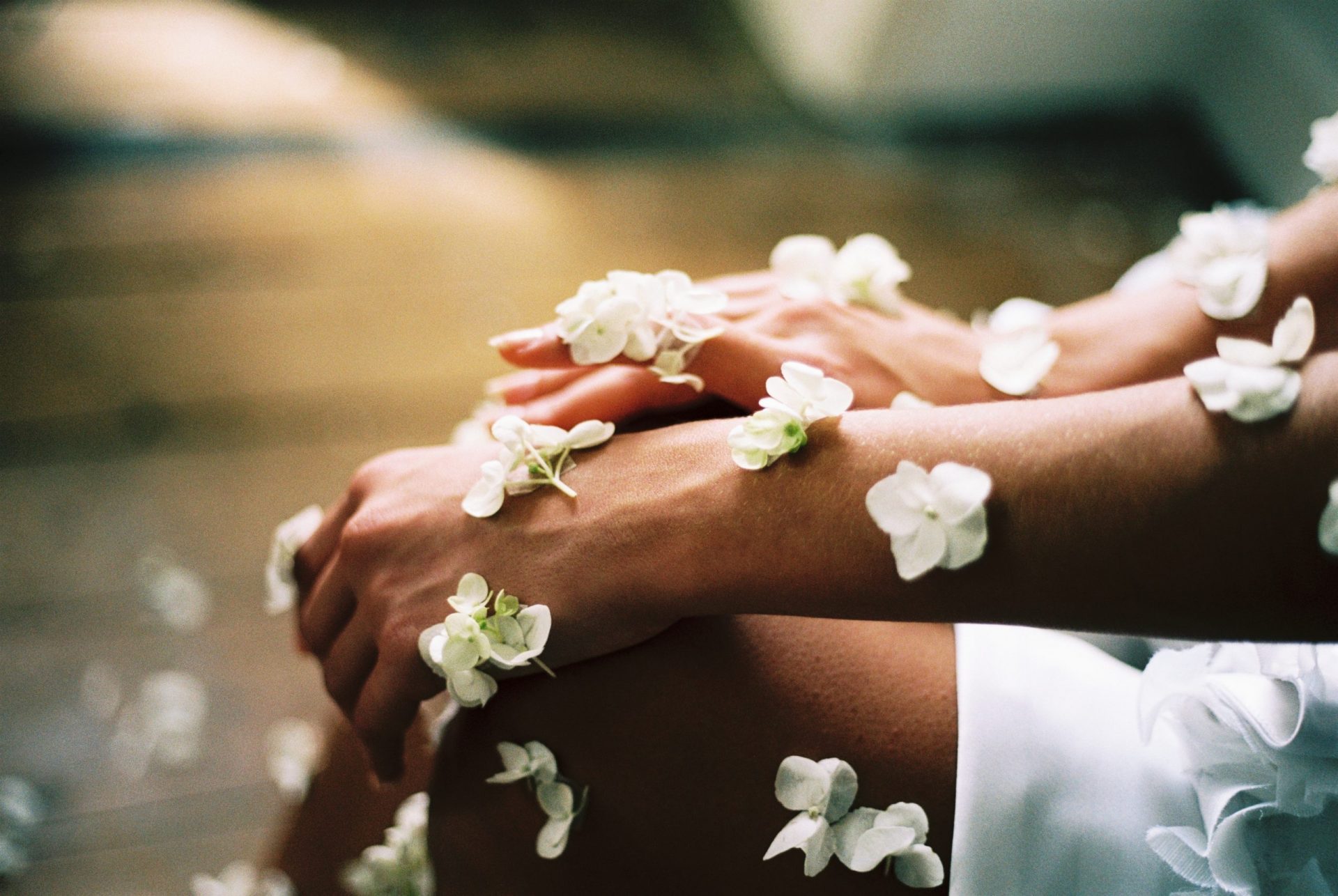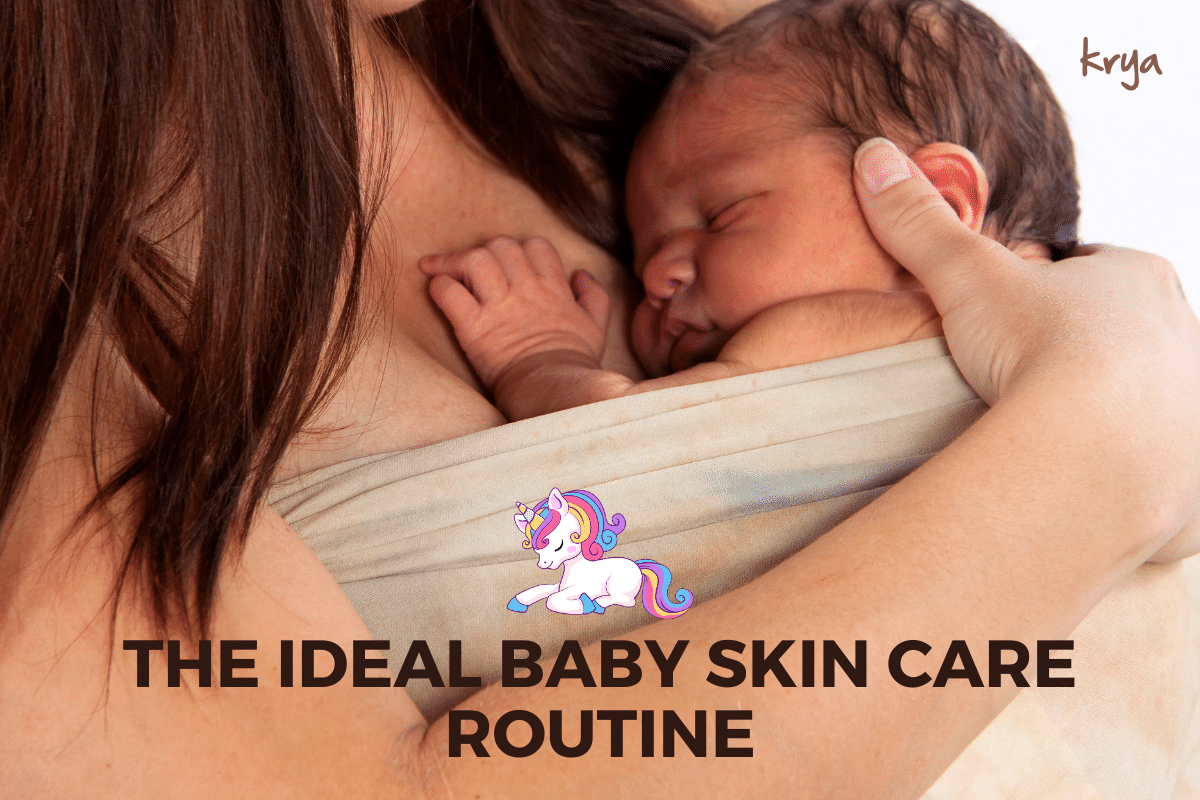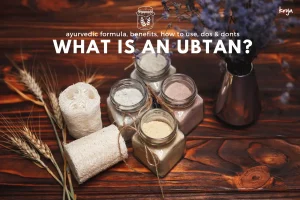This post was last updated on November 21, 2022 by Preethi Sukumaran
If you do a search for oily skincare routine, the following are the most likely results
Commit to an oil busting routine, screams one headline. Make sure you exfoliate often to slough off dead cells and keep those pores squeaky clean, says another. Try using an oil balancing clay mask at night, another suggests helpfully.
In other words, we should be waging war on our oiliness. Continuously cleansing, toning, exfoliating supposedly keeps our oiliness at bay. Keeping sebum secretion to a balanced state seems to be their one-point agenda in building an oily skincare routine.
But most websites, magazines and experts are mysteriously quiet on just exactly why our skin got to be this oily? Stress, genetics and environmental factors are the supposed underlying reasons . But no specific answers.
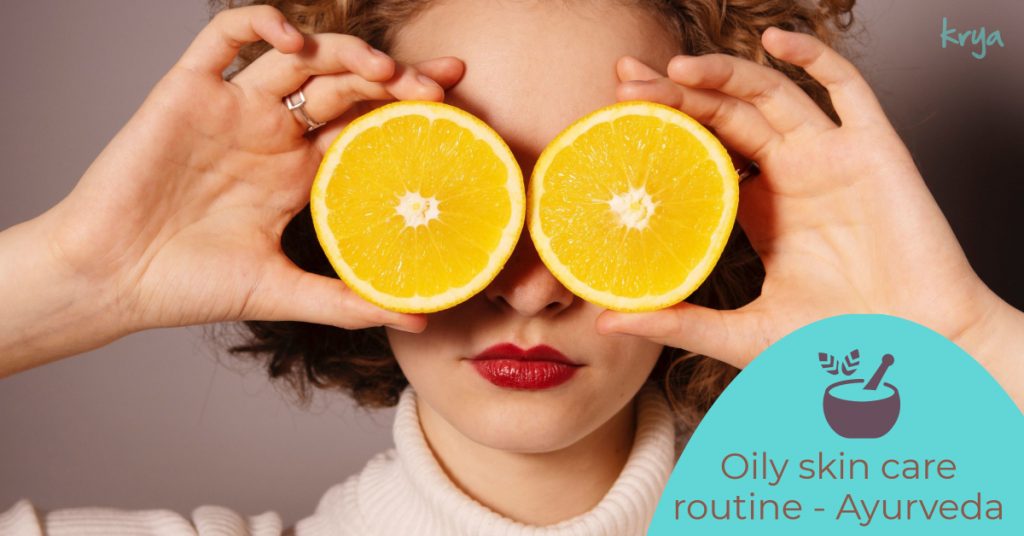
Why is the sight of a samosa causing our pores to drip oil? What are these mysteriously open pores? Should the word “mattify” be burned into our brains? And most importantly how should we ideally care for oily skin? How do we nourish oily skin without causing an oil rig like an explosion?
Prakriti (individual constitution): a valuable tool to identify the correct dosha imbalance in skin
Ayurveda classifies our prakriti as the unique mixture of doshas that make up who we are. This also includes unique factors like our age, the season, the climatic conditions where we live, current stresses ,life stage, etc.
Each of these factors contributes to our prakriti at any point in time. Depending upon where we live, season, age, etc., our natural prakriti may see a small change. This can cause an imbalance which can lead to skin, hair or other health issues.
Characteristics of Pitta Type Skin
When Pitta is elevated in our basic constitution (prakriti) we exhibit the characteristics of this dosha in our skin, hair, behaviour, response to stress and the foods we enjoy.
Pitta type skin tends to sweat easily, have more oiliness, is sensitive to heat and spicy foods, and is quickly irritated and gets inflamed.
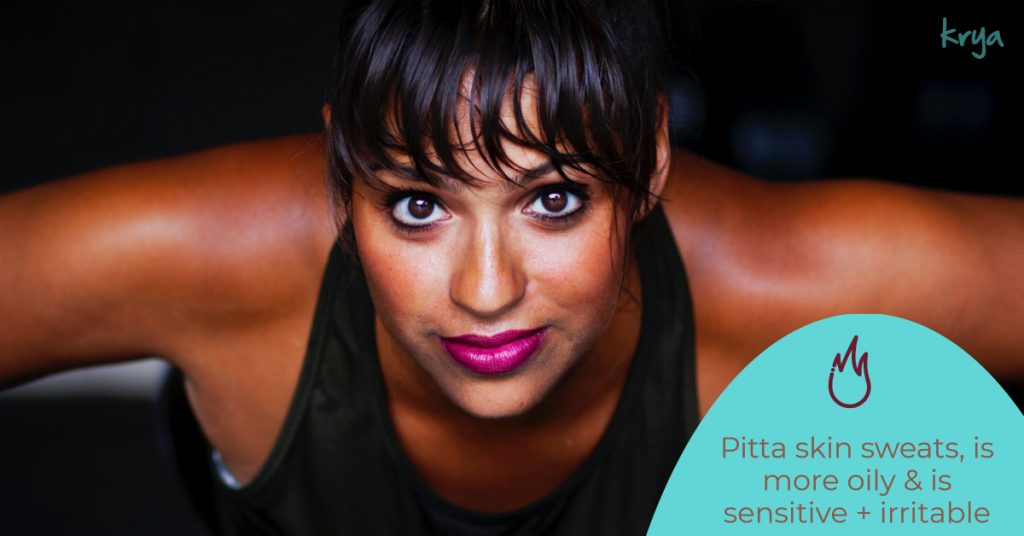
Pitta dosha is characterised by its swift response to situations – like Fire (Agni) which is an important part of Pitta dosha, pitta based skin also reacts quickly to stimuli. So if you are prone to breakouts, have a skin that you describe as sensitive and find that any changes in product/food can cause breakouts or reactions, you probably have pitta type skin.
Oily skin – and how it is linked to our life stage, food, behaviour and genetic makeup
Ayurveda tells us that “like responds to like”. Therefore, when we eat foods, have certain lifestyle practices that stimulate pitta dosha, we can trigger “pitta like” changes in skin and hair. This could be despite the fact that we are not genetically dominant in Pitta dosha.
So for example, if you constantly eat pitta aggravating foods, work in a very high-stress environment, respond very quickly with anger or type A behaviour, you constantly draw on Pitta dosha in your body. This leads to Pitta being overblown in your body leading to Pitta type skin and hair issues like oiliness, sensitive skin, redness and rosacea, premature greying, hair thinning, hair oiliness, etc.

Pitta dosha is also closely linked to the body’s hormonal system and blood tissue. In certain periods of our life when we are naturally prone to hormonal changes like teenage, menstruation, pregnancy and perimenopause, we tend to elevated levels of Pitta in the body. This can lead to pitta type skin issues.
Ayurvedic oily skincare routine – how to cleanse pitta skin
Ayurveda gives us very clear rules for Skin cleansing. Our Skin is always cleansed with an optimum combination of herbs, grains and lentils. This ensures that the skin’s pH and barrier function is well maintained. Depending upon the prakriti of the individual and ritukala (season), specific herbs are added to the base.
When cleansed this way, the sebum levels in the skin are never suddenly depleted or produced in excess. Skin remains soft and does not feel parched and tight. Most importantly, the cleansing is strongly functional and removes clogged material and toxins from the cells. This frees up the skin and helps it function normally.
In pitta aggravated skin, Ayurveda suggests that we follow a few special rules while cleansing skin to avoid stimulating Pitta dosha further:
- Cleanse in cool water as much as possible – warm or hot water aggravates Pitta and is anyway NOT suggested in Ayurvedic facial care
- Use only mridu (gentle) pitta balancing, soothing herbs. Even strong cleansing herbs like Shikakai, Soapberry can be avoided for pitta prone skin. Instead, we are asked to use adsorbent based cleansing using gentle clays and lentils
- The processing of herbs and grains and clays must be done to a very fine degree. The herbs must form a gel like thick paste in water – this ensures they do not scratch or irritate the skin stimulating pitta dosha
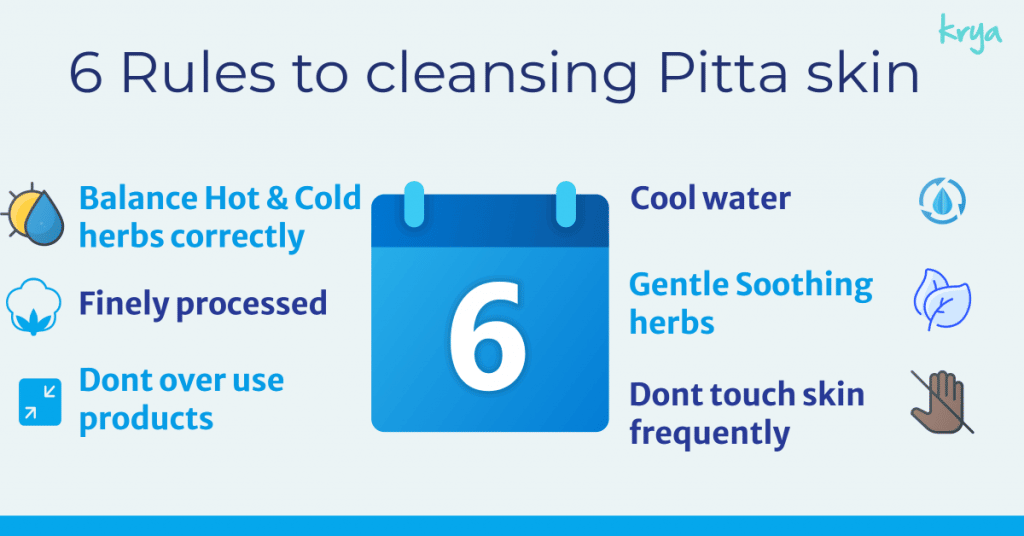
- The use of Ushna (hot) and Teekshna (intensive) herbs must be very closely monitored. Even if they are used in the formulation, they must be balanced by Sheetya (cooling) and Swadu (sweet) herbs. For example –there are many homemade and DIY formulations that rely very heavily on Haridra (turmeric). Turmeric is no doubt a very renowned skincare herb, but it has a very “ushna” or hot nature. If used indiscriminately without balancing herbs, it can increase the Pitta component of the product irritating Pitta type skin.
- Products (even well-formulated Ayurvedic products) must not be overused. For example, many people with oily skin believe they must use Facial masks more than once a week. They also over-cleanse the skin and sometimes even when not necessary double or triple cleanse skin in the mistaken belief that this is helping their skin. Over cleansing and repeated stripping of skin sebum provokes a higher drawing of pitta dosha. So the routine must not be overdone
- Do not handle skin frequently– as oily skin is a manifestation of Pitta dosha that has aggravated throughout the body, every part of the body is usually high in Pitta. Therefore, our sweat, secretions from the rest of the body are also high in Pitta. Over handling skin, touching it or picking at it also irritate and aggravate Pitta leading to minor breakouts, inflammations etc.
The Krya Classic Face wash has been formulated following all these principles in mind for pitta aggravated oily skin. It is made from a mix of 25 Ayurvedic herbs, clays and grains. We use very interesting cooling and pitta balancing ingredients like Organic Ragi, Organic Himalayan Chamomile, Organic green tea, Triphala, and Pomegranate peel. The product is very refreshing, soothing yet deep cleansing on the skin. It does not irritate skin and cleanses the skin well. We recommend using once or twice a day using clean, cool water. This video demonstrates how to use the Krya face wash correctly on skin. If you are unsure about how and why you should use a powder cleanser for facial skin, do read this post.
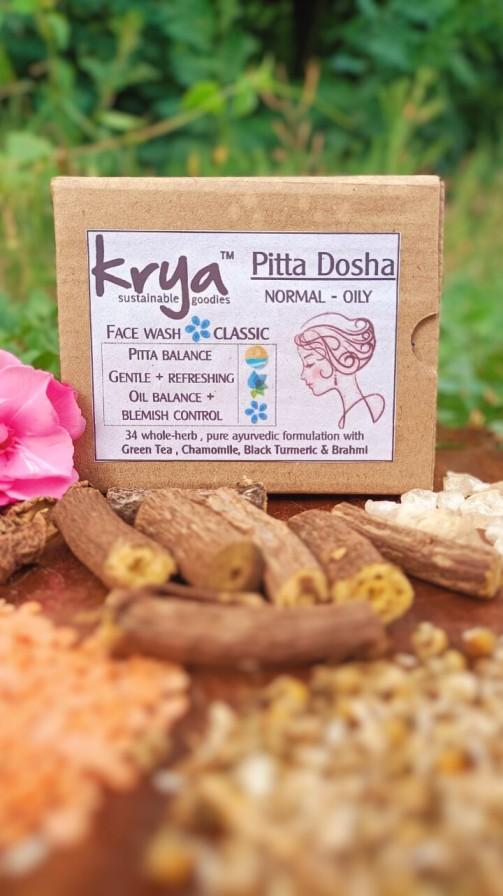
Classic Face wash for Oily Skin | Balances Sebum . Clarifies Skin.
Ayurvedic oily skincare routine – using a Face Lepa
Ayurvedic Lepas help heal skin, balance dosha imbalances and help draw out excess Pitta from the face. Heat exchange is especially important in facial skin, as the face houses the eyes and brain.
Due to continuous activity, this area can easily get overheated disrupting the pitta-kapha balance. Therefore, all applications above the neck areas should only be done with products that are designed to draw out excess pitta.
Ayurvedic face Lepas are astringent, toning and mildly tightening in nature. So they can sometimes irritate Pitta aggravated skin. To balance this, Pitta aggravated Face Lepas are normally advised to be mixed with rose water and applied only once a week. When Pitta is under control, the face masking can be done twice a week. But it is advisable to start initially slowly allowing time for Pitta to stabilise.
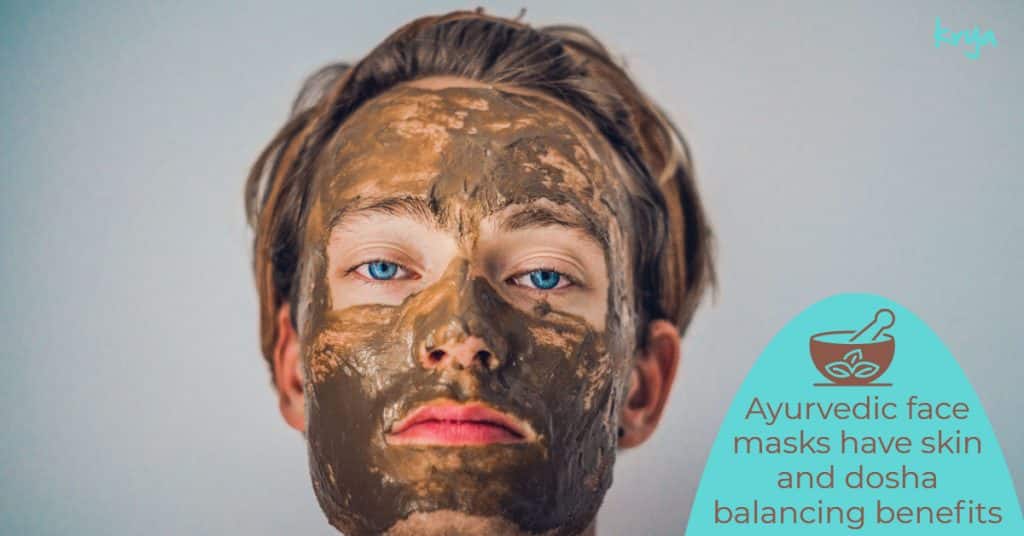
Here is a detailed blog post on how to correctly use a face lepa. Here is a video demonstrating this as well.
The Krya Classic Face Lepa is an ideal Ayurvedic Face Lepa that suits oily, pitta aggravated skin. It is made from 32 Classic Ayurvedic herbs, grains and clays. Every ingredient is carefully chosen, sourced from high-quality sources, and sourced organic wherever possible. We use a mix of deep cleansing, astringent, sebum balancing, soothing and pitta balancing herbs like Shatavari, Manjishta, Lodhra, Arjuna, Ashoka and Shirisha. With regular use, the skin feels cool, refreshed, soothed, balanced and there is deep cleansing and unclogging of the srotas allowing healthy functioning of the skin and minimised looking pores.
To start with this product can be used once a week, and followed up with the Krya Classic skin serum. Do not wash the face again that day after using this Face Lepa. Also, avoid stepping out and exposing skin to further dirt and pollution on the day the Mask is used.
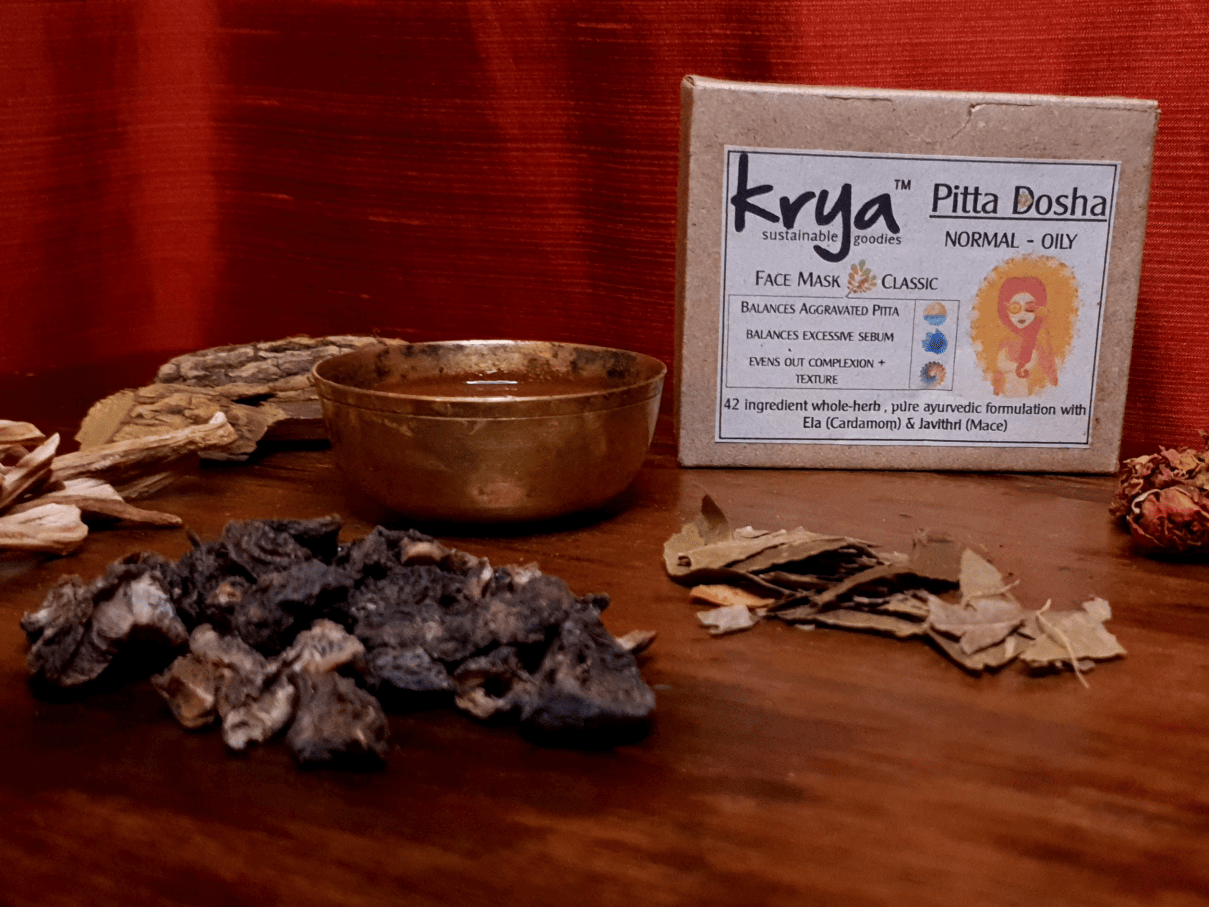
Krya Classic Face Mask – clarifying , skin nourishing
About:
- Made from a researched and tested formulation that contains 14 organically grown and forest collected lentils and herbs including Mulberry Leaf, Mulberry fruit, Guava fruit & Oatgrass.
- The herbs used in this formulation have a natural skin clarifying, nourishing and skin smoothening action. Your…
Ayurvedic oily skincare routine – using serums for balanced nourishment
The concept of emulsions is very well known in Ayurveda: so many ancient recipes for Ayurvedic creams exist. However, lotions are not a common skincare format in Ayurveda. For skin application, different kinds of oils are routinely used.
Many specific facial oils are referred to in Ayurveda: kumkumadi tailam is one such formulation, which has now become extremely well known. This is a very ancient formulation said to have been developed by the Ashwini Kumaras. Kumkumadi tailam is generally used for youvana pidaka (Acne) or skin that has hyperpigmentation, blemishes and darkening due to excess pitta or sun exposure.
However, when using products on the skin, Ayurveda shares a few concerns:
- Skin is supposed to perspire and do heat exchange with the atmosphere keeping the rest of the body cool
- Sweda (sweat) is an important vehicle to remove excess salts, and toxins that are excreted from the body. The proper production of Sweda supports other excretory organs like the kidneys which can get overloaded if your skin does not do its work
- Therefore, the goal of Ayurvedic skincare is to properly moisturise the skin and all its layers and then cleanse it well so the minor srotas (circulatory channels) are open and functioning well to do their job of heat regulation and cleansing.
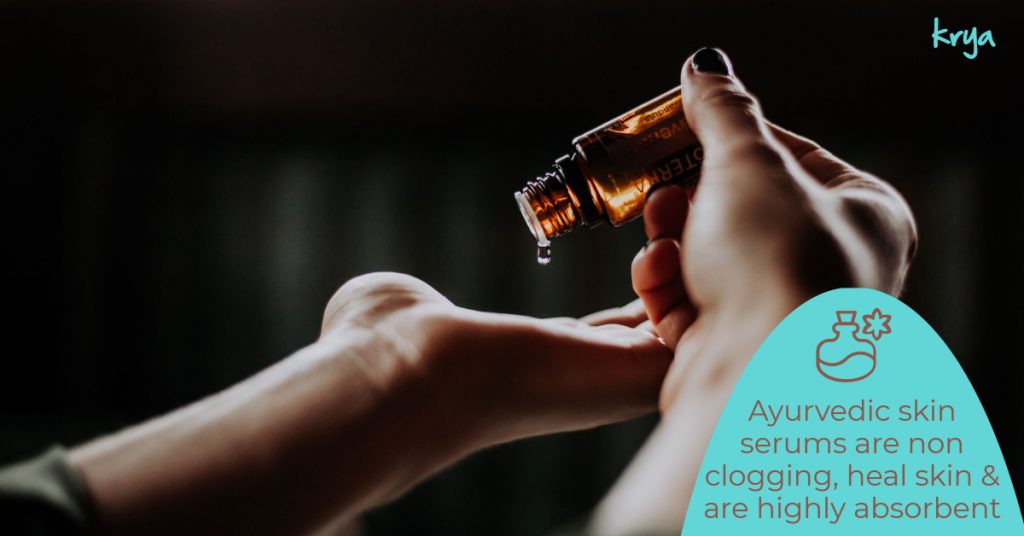
Therefore, we should not clog the skin with the excessive layering of skincare products. Because this blocks skin and discourages the free exchange of heat, sweat and Malas from the body.
Apart from balancing pitta, the oils must be “sookshma” (subtle). They should easily penetrate the skin. They should not block or impede the skin in any manner. And they should be effective even in very small doses.
To formulate our line of Ayurvedic skins serums, we spent a lot of time researching the needs of different kinds of skin. The idea behind each product was to provide each skin with the exact Dosha balance it needed. So, we had to figure out the right set of herbs and base oils that can help .
In Oily, Pitta prone skin, there is a need to draw out excessive Pitta from the skin by balancing the Agni in the skin. We do not just focus on removing “excess sebum”. By working on the conditions that caused the excess sebum in the first place, we encourage the natural gradual balancing of sebum levels in the skin.
The Krya Classic skin serum has been formulated with 26, pitta balancing, soothing, oil balancing herbs like Manjishta, Patranga, Ela, Clove, Nimba, Shirisha etc.
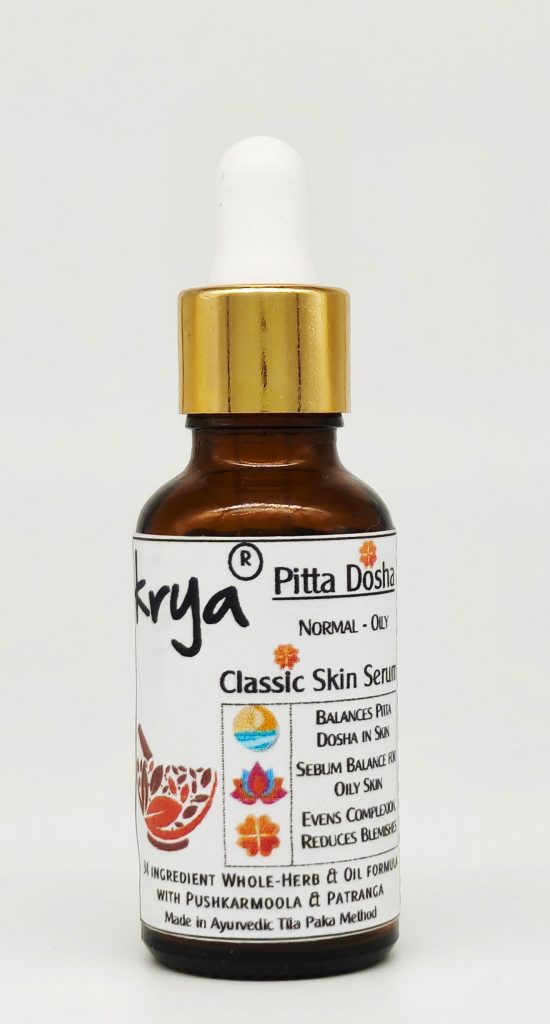
Classic Face serum for Oily Skin – Oil Balance, Skin Clarity, Pitta Balance
We prepare the Krya Classic skin serum in the Ayurvedic Tila Paka veedhi . Over 4-6 days, We hand stir the oil and manufacture it . The team progressively adds fresh plant juices, herbal decoctions and herbal pastes to the oil mixture. This slowly infuses the oil with bio-actives from each herb . Over the process, the base oils completely transform in characteristics becoming very nuanced, subtle and highly penetrative into the skin.
For this oil, we use 8 plant oils and butter including extract based oils. For the pitta balancing and skin healing effect, we use Kokum butter, Coconut Oil and Karanja Oil.
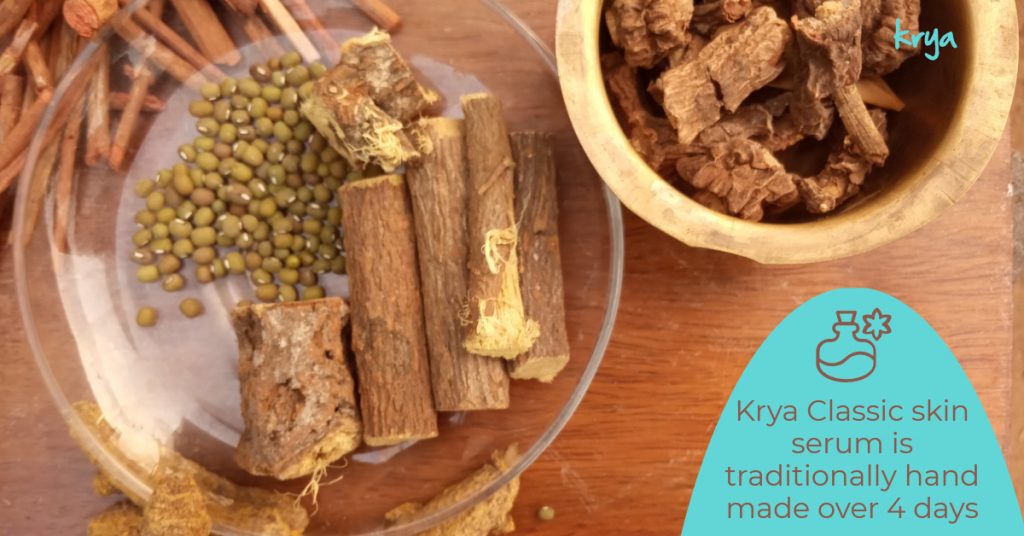
Even Pitta prakriti skin can go dry in certain conditions. This is due to excess heat. So we need a skin moisturising product that also balances Pitta here. Continued use of the product helps work on minor skin blemishes, scars and evens out skin tone and lustre.
To sum up: An ayurvedic skincare routine for oily skin
I hope you found this post explaining how Ayurveda understands and helps care for oily skin useful. We write these posts for 2 reasons. The first is to provide a deeper understanding of Ayurveda and its unique perspective on hair and skincare.
The second is to share the internal working behind our products and our company. This helps improve transparency and gives you a greater understanding of what makes us tick.
We believe that greater knowledge and transparency promotes better choices. This helps you make better decisions on what you apply to yourself or use around you in your home.
If you have any questions on our products, product philosophy, or skin and hair, please do email us. For personalised recommendations of the correct skin and hair care products please WhatsApp our Customer Service team.

